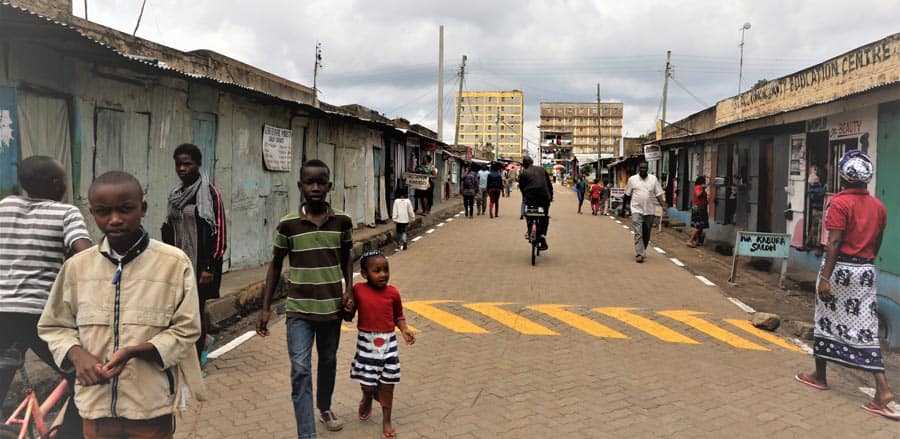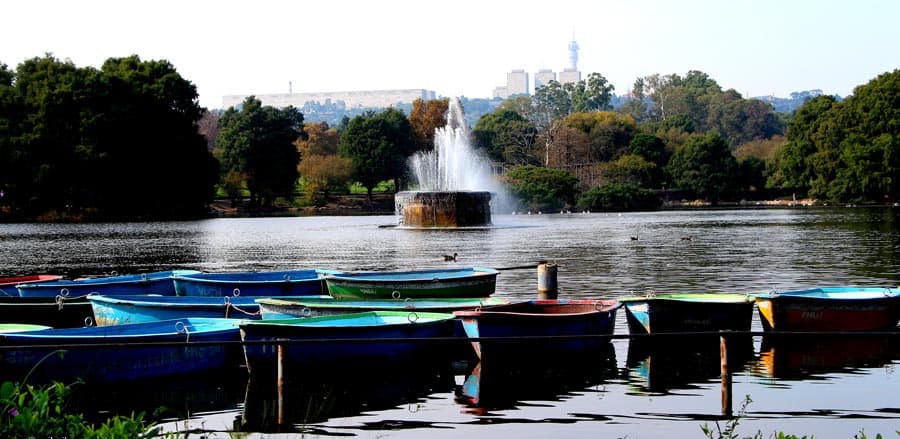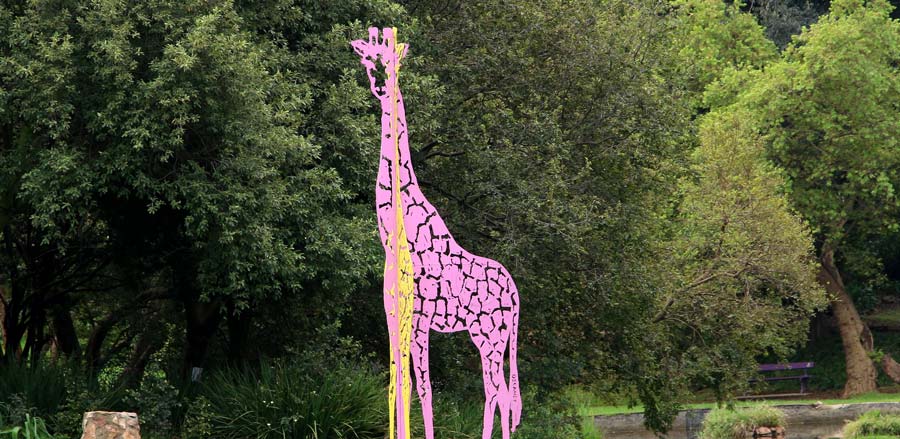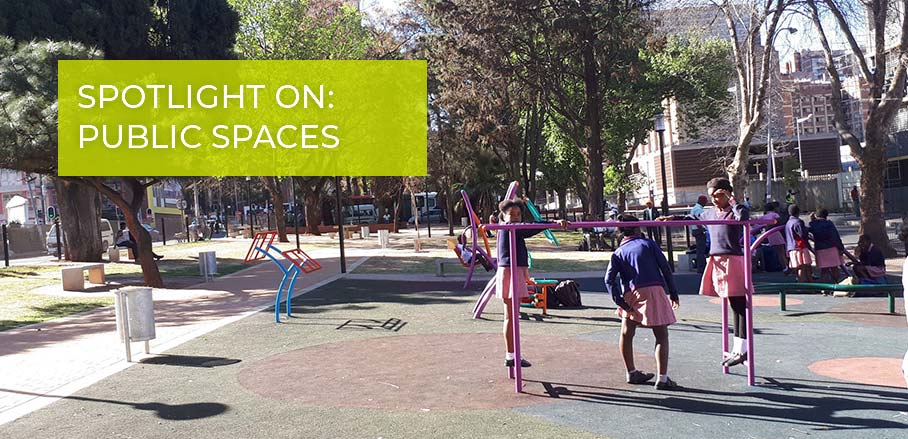Towards Pan-African Spaces of Publics
African cities need to develop unique, context-sensible conceptions of public space, argues Ayanda Roji.
Public Spaces Beyond European-Style Models
African cities are undergoing rapid urbanisation as well as transformations in their health and socio-economic sectors. Public spaces, where people of different ethnicity, religion, gender, and class meet, are both a projection surface of society and an arena of action for a wide range of development needs, such as economic activities, conservation, safety, mobility, health, and well-being. Yet the concept of public space in African cities is often considered too narrowly, delimited to green and tranquil European-style parks, reserves, or botanical gardens, which do not necessarily reflect the diverse needs and priorities of urban residents.
While these European-style spaces are important as they enhance the character identity and vitality of local neighbourhoods, towns and cities, in Africa there are other forms of open and closed public assets. While these are heavily used, much loved, and essential to social life and the fabric of communities, they are not generally referred to as public spaces. They range from bustling and noisy transport nodes, vibrant community centres, spaces of protest and places of worship to messy and dynamic markets and street trading areas. But they are more than just lively spaces for people. They are also part of a place’s cultural, social, and economic heritage, where communities come together to interact, work, explore, pray, play, exercise, relax, learn … or just breathe.

Dandora model – Open Street in Dandora, Eastern suburb in Nairobi, Kenya, © UN HABITAT/Julius Mwelu
A Question of Context
Thus, it is also critical to affirm what notions such as the “right to the city” may mean in such contexts. Although this has often entailed reasserting the ‘publicness’ of public spaces, ‘public’ in itself is a term that is generally used but little interrogated in terms of how the spaces are understood, designed, used, and managed in order to be inclusive of groups with divergent opinions on societal issues.
Hence, social contexts need to be considered as much as their physical spaces – ‘spaces of publics’ as much as ‘public spaces’. The concept of ‘spaces of publics’ provides a useful framing for how planning and design must respond to the needs and particularities of the place and various groups spaces must serve, underlining that design must always be adaptable. Neglecting to do so, particularly in the face of rising inequalities and injustices, could compound existing exclusion of vulnerable groups.
Due to pressing issues related to inadequate housing, sanitation, and a range of developmental challenges many African cities face, public spaces tend to receive less attention. However, they are important, as they serve as extended living rooms, stimulating communal activities and providing people with space to socialise, relax, and transact. Public spaces are also a vital economic asset and major contributor to livelihoods in a context like that on the African continent, where 85 per cent of the population work in the informal economy.
Related to ideas about public space being parachuted into Africa from the West, the value and meaning of public space in the African context is largely unexplored and undocumented. Even when public space projects of merit are completed, the knowledge mostly remains invisible, siloed, or disconnected, rather than contributing to an incremental archive of good practices. The inevitable results are:
- A lack of understanding and analysis of urban public spaces where collective, convivial public life takes place.
- A limited range of planning and design practices that reflect local cultural, social, and economic needs and give meaning to ‘Africanness’ in their imagination of urban public spaces.
- A missed opportunity to build capacity for officials, community actors, and advocacy groups to develop policy and practices for the preservation and development of African public spaces.
Overall, public space is not mainstreamed in city governance, public policy, and implementation, but rather seen as a nice-to-have or a last addition to housing, infrastructure, and neighbourhood development projects.
The Centre on African Public Spaces
The above is the basis for the creation of the Centre on African Public Spaces, an initiative embarked on by the City of Johannesburg in collaboration with African universities and cities, as well as with civil society advocacy groups. The aim is to contribute to the understanding of the meaning, role and function of public spaces that is place-specific.
The initiative is timely, as the United Nations recognised the importance of public space as part of the Sustainable Development Goals (SDG). SDG 11.7 seeks to ensure by 2030, “universal access to safe, inclusive and accessible, green and public spaces”, while Aspiration 4 in the African Union’s Agenda 2063 calls for “safe and peaceful spaces for individuals, families and communities.”
Taking a wider Pan-African view, the Centre seeks to support the advancement of the public space field by filling the current gaps in knowledge and documentation. As such, it will serve as a platform for learning, connecting cities, people, and ideas to reimagine Africa’s public spaces through collaborative research, teaching and training, and advocacy.
Apart from elevating an African perspective on how public spaces are defined, planned, designed, developed, and managed, there are several other initiatives that gave impetus to the establishment of the Centre. The first is the Inner-City safe public space project that the City of Johannesburg implemented in the Doornfontein Inner-City neighbourhood, together with UN-Habitat Global Public Space Programme, the GIZ Inclusive Violence and Crime Prevention (VCP) Programme, and the local organisation Sticky Situations.
The pilot project was aimed at transforming inner-city parks into safe and inclusive community spaces. The initiative highlighted issues that are fundamental in the development and management of public spaces. These range from integrated approaches to cross-sectoral planning, social programming (activation) to strong community participation and ownership.

Zoo Lake © Gail Scott Wilson
Another motivation for founding the centre is rooted in African cities’ regional and international engagements, wherein the notion of public space and placemaking was discussed. In this work, including research with African universities, the need for a focal point that amplifies African voices, shares African experiences, and grows African expertise around public spaces was highlighted in order to exchange lessons on how best to combat the loss of public spaces among other issues.
More specifically, the Centre seeks to reimagine public spaces through focussing on four work streams;
- Public sector capacity strengthening: collaborative visioning, planning, design, maintenance, and management of public spaces among city authorities.
- Active citizenry: strengthening the capability of civil society organisations to support communities in organising and advocating around public space.
- Cross-sectional research and teaching: undertaking interdisciplinary and transdisciplinary research into the design and management of public spaces in African cities.
- Knowledge exchange: sharing knowledge, home grown solutions, and cross-cutting learning from the various projects across the continent.
How Can You Contribute to the Centre?
- Currently, the Centre on African Public Spaces is in its early stage. It needs nourishment through bold ideas and initiative, with the support and involvement of a wide range of actors in different ways, for example:
- Municipalities and cities can share their public space successes and challenges, participate in training and capacity-building, collaborate in research and good practice pilots and innovations.
- Universities and research institutes can join the movement to mainstream public space, as part of developing curricula across disciplines and as a crucial element of educating future city makers.
- Practitioners and professionals can work with community actors, academia, and city officials to improve public space design and development and influence urban policy and practices within cities.
- Civil Society and communities can shape the preservation and development of public spaces that work for all, as the users and strengthen public space advocacy through collaborating with other civil society organisations on the continent.
The Centre responds to the need to develop ‘home-grown’ or localised knowledge, visions and ideas for imagining, designing, and planning public spaces, as part of integrated human settlements. This means involving local communities, to ensure that public spaces are rooted in, and respond to, the geography, culture, and histories of cities in Africa.

The Wilds © Gail Scott Wilson
- Towards Pan-African Spaces of Publics - 23. July 2020
